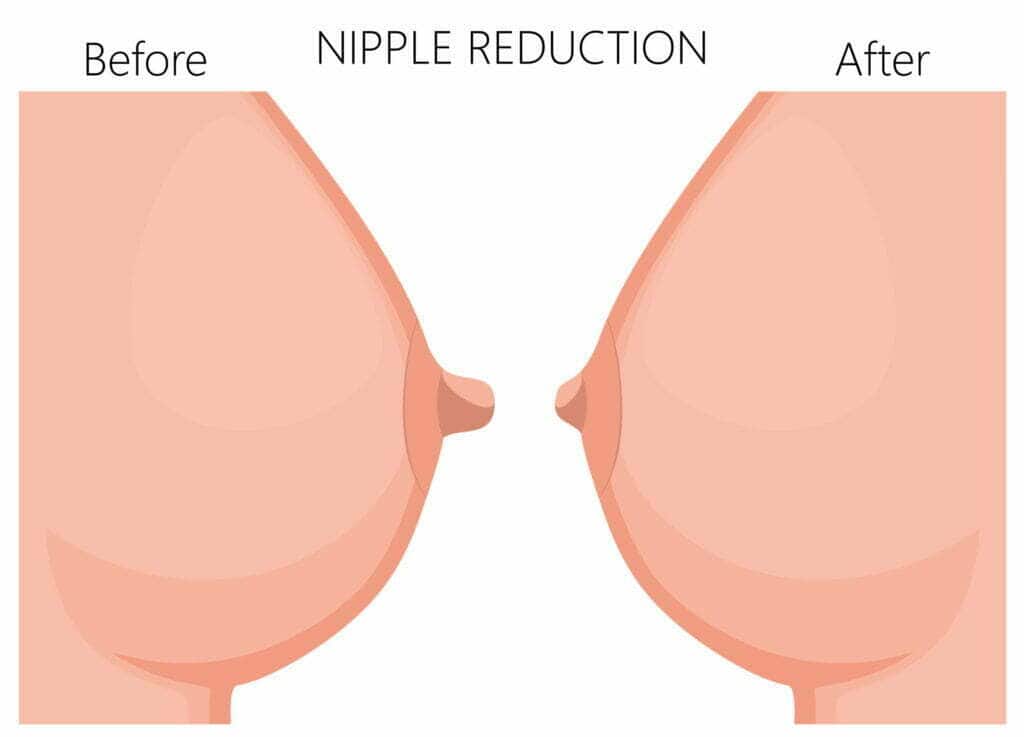The Mini Makeover: Aesthetic Appeal through Nipple Reduction
Nipple reduction surgery is a procedure that targets individuals seeking to alter the size of their nipples for aesthetic or comfort reasons. This surgical intervention, while less talked about compared to other cosmetic surgeries, offers significant benefits for those feeling self-conscious about nipple prominence. By focusing on precise techniques and recovery processes, this operation can enhance one’s body image and confidence. The decision to undergo nipple reduction should be informed by understanding the procedure’s nuances, potential outcomes, and post-operative care requirements.
Overview of Nipple and Areola Reduction Treatments
Nipple vs. Areola
Nipple reduction targets the nipple itself, making it smaller or shorter. This can help if you feel self-conscious about their size. On the other hand, areola reduction focuses on the dark area surrounding the nipple. It’s ideal for those who want a more proportionate look.
Both procedures aim to enhance breast aesthetics. They can be done separately or together, depending on your needs.
Surgical Options
Surgical methods provide permanent results for reducing nipple and areola size. These include excision techniques where excess tissue is removed. Another option is the concentric method, used mainly for areola reduction.
These surgeries usually take one to two hours under local anesthesia. Recovery time varies but typically involves minimal discomfort. Patients often return to normal activities within a week.
Non-Surgical Alternatives
Non-surgical options involve less downtime and risk than surgery. Laser treatments and fillers can sometimes adjust appearances subtly but might not offer permanent solutions. They’re best suited for minor adjustments or those hesitant about surgery.
Pros:
- Less recovery time needed.
- Lower risk of complications.
Cons:
- Results may not be as dramatic or long-lasting as surgical methods.
Improved Symmetry
One key benefit of these treatments is achieving better symmetry between nipples and areolae. Many people find that even small adjustments make a big difference in how they view their bodies.
Feeling confident in your appearance boosts overall well-being. Choosing the right procedure depends on individual goals and physical characteristics.
Reasons and Benefits of Nipple Reduction
Self-Esteem Boost
Nipple reduction surgery can significantly improve how individuals feel about their bodies. Many people experience discomfort or embarrassment due to the size or shape of their nipples, which affects their self-esteem. This procedure offers a way to address these concerns.
Feeling confident in one’s appearance is crucial. After undergoing nipple reduction, patients often report feeling more comfortable wearing different types of clothing without worrying about the appearance of their nipples. This newfound confidence can open up a world where they feel better about themselves and less self-conscious in social situations.
Comfort Enhancement
Physical comfort during daily activities or sports can be hindered by large or protruding nipples. They may cause irritation under tight clothing or when engaging in physical activity, leading to discomfort that can now be alleviated through nipple reduction surgery.
Post-surgery, many find that they no longer experience chafing or irritation from fabrics rubbing against sensitive areas. This improvement makes it easier for them to participate in various activities without discomfort, enhancing overall quality of life.
Aesthetic Improvement
One of the primary reasons individuals opt for this surgery is to enhance breast aesthetics and achieve proportionality between the breasts and nipples. An imbalance here can distract from the natural beauty of one’s figure.
After undergoing nipple reduction:
- Patients notice a more balanced look.
- The proportions between their breasts and nipples become harmonized.
- Their entire silhouette appears more aesthetically pleasing.
This enhancement not only improves how they view themselves but also how clothes fit and drape on their body, contributing further to an improved self-image.
Procedure Expectations and Surgical Techniques
Local Anesthesia
Nipple reduction surgery often takes place under local anesthesia. This means you stay awake but won’t feel pain in the surgery area. It’s a common choice for outpatient settings.
Doctors use special techniques to make sure you’re comfortable during the procedure. They carefully numb the nipple area before starting. You might feel some pressure, but there should be no pain.
Incision Patterns
The type of incision depends on your goals for nipple reduction.
- Transverse incisions are one option. They are horizontal cuts across the nipple.
- Another method is a circular incision around the base of the nipple.
Surgeons choose these patterns based on how much they need to reduce size or change shape.
After making an incision, surgeons remove excess tissue from either the tip or base of the nipple. Then, they close up with stitches that form a circumferential line around it.
Realistic Outcomes
Setting realistic expectations is key for satisfaction with nipple reduction surgery outcomes.
Results depend on several factors:
- Original size and shape
- The chosen surgical technique
- Individual healing processes
Most people see significant improvements in appearance and comfort after healing completely from this ancillary procedure. However, perfect symmetry or “ideal” nipples may not always be achievable due to natural variations in human anatomy.
Ideal Candidates and Eligibility for Surgery
Health Criteria
To undergo nipple reduction surgery, good health is crucial. This means having no major illnesses or conditions that can affect healing. Patients must also have a history of good wound healing. Those with chronic diseases or poor healing histories might face complications.
Good health ensures the body can recover smoothly from the procedure. It reduces risks associated with surgeries in general. Before considering this surgery, one should consult with their doctor to ensure they’re fit for it.
Stable Breast Size
For optimal results, a stable breast size is important before undergoing nipple reduction surgery. This stability means that breasts have not changed significantly in size for about a year. It’s especially relevant for women who might consider pregnancy or breastfeeding in the future.
Breast changes during these periods can alter surgical outcomes. Thus, ensuring stability beforehand leads to more predictable and satisfactory results after surgery.
Exclusion Criteria
Certain individuals are not suitable candidates for nipple reduction surgery:
- People with active infections at or near the surgical site.
- Individuals with poor wound healing history.
These conditions can lead to complications during and after the procedure.
Preparing for Nipple Reduction Surgery
Smoking Cessation
Stopping smoking is crucial. It promotes healing after surgery. Smokers face longer recovery times. Their risk of complications is higher too.
Nicotine constricts blood vessels. This slows the healing process. Quitting smoking weeks before the procedure helps your body prepare.
Medication Avoidance
Some medications increase bleeding risks during nipple reduction surgery. It’s important to avoid them.
Aspirin and anti-inflammatory drugs are examples. They can cause more bleeding during and after surgery. Your surgeon will provide a list of medications to avoid.
Herbal supplements should be stopped too. Some can affect anesthesia or bleeding.
Post-Surgery Support
Arranging support at home is vital for recovery from nipple reduction surgery.
- You’ll need someone to drive you home after the procedure.
- Help with daily tasks is often necessary in the first few days.
Having a friend or family member available can make recovery smoother and safer.
Postoperative Care and Recovery Tips
Surgeon’s Instructions
Following your surgeon’s care instructions is crucial for a smooth recovery after nipple reduction surgery. These guidelines are tailored to your specific needs. They help minimize the risk of complications.
Your surgeon will provide detailed advice on how to care for the surgical site. This includes keeping it clean and dry. Adhering strictly to these instructions supports proper healing.
Recovery Timeline
The typical recovery timeline varies but generally spans a few weeks. During this period, patients must limit certain activities to avoid straining the surgical area.
In the first week, you should rest as much as possible. Avoid lifting heavy objects or engaging in strenuous exercise until cleared by your doctor.
Managing Discomfort
Discomfort is common after surgery but can be managed effectively with medication prescribed by your surgeon. Over-the-counter pain relievers may also be recommended.
Applying cold packs can reduce swelling and provide relief. However, always wrap them in cloth to protect your skin.
Monitoring Complications
It’s important to monitor for signs of complications such as infection or excessive bleeding. Key symptoms include unusual redness, warmth at the site, or unexpected discharge.
If you notice any concerning symptoms, contact your surgeon immediately for evaluation and guidance.
Combining Nipple Reduction with Breast Augmentation
Cohesive Results
Opting for nipple reduction surgery alongside breast augmentation offers a harmonized appearance. This combination ensures that the size and shape of the nipples complement the new breast contours. Patients often find this approach yields more balanced and natural-looking outcomes.
By addressing both concerns in one procedure, individuals can achieve their desired aesthetic with fewer surgeries. This holistic approach to body contouring allows for tailored results that align closely with patient expectations.
Implant Considerations
Choosing the right implants is crucial when combining procedures. The type, size, and placement of implants must be carefully selected to match the reduced nipple size. Surgeons consider factors like body frame, existing breast tissue, and personal preferences during consultation.

Silicone and saline are popular choices, each offering distinct advantages. Silicone implants provide a more natural feel, while saline options allow for adjustable sizes post-surgery.
Cost & Recovery Savings
Undergoing nipple reduction surgery with breast augmentation can lead to significant savings in both cost and recovery time. Patients benefit from a single anesthesia fee and hospital stay instead of paying separately for two procedures.
Recovery is streamlined into one period rather than enduring separate downtimes. This efficiency not only reduces overall expenses but also minimizes disruption to daily life.
Selecting the Right Surgeon for Your Needs
Board Certification
Choosing a surgeon with board certification is crucial. This ensures they have undergone rigorous training and testing in their field. For nipple reduction surgery, experience matters as much as formal qualifications.
Board-certified surgeons are skilled in various techniques. They understand how to achieve natural-looking results while ensuring patient safety. Always verify a surgeon’s credentials through reputable medical boards.
Before-and-After Photos
Reviewing before-and-after photos of actual patients can give insights into a surgeon’s expertise. These photos highlight the changes achieved through surgery and showcase the surgeon’s aesthetic style.
Look for examples that match your desired outcome. This helps set realistic expectations for your own procedure, especially if combining it with breast augmentation.
Consultations Matter
It’s wise to consult with multiple surgeons before making a decision. Each consultation offers new information about what can be achieved with nipple reduction surgery.
During these meetings, discuss:
- The expected outcomes
- The surgical technique used
- Recovery time
- Cost involved
Consultations allow you to gauge whether you feel comfortable and confident in a surgeon’s care.
Final Remarks
Nipple reduction surgery offers a transformative option for individuals seeking to enhance their physical appearance and boost self-confidence. This detailed exploration, from the overview of procedures to selecting the right surgeon, underscores the importance of informed decision-making. It highlights that ideal candidates are those informed about the procedure, recovery, and realistic outcomes. Moreover, combining nipple reduction with breast augmentation emerges as a viable option for comprehensive aesthetic enhancement. The emphasis on postoperative care and selecting a skilled surgeon is crucial for achieving desired results while minimizing risks.
For those considering this surgical intervention, it’s imperative to consult with a board-certified plastic surgeon who can provide personalized advice tailored to individual needs and expectations. Taking this step ensures not only safety and satisfaction but also contributes to the broader understanding of cosmetic surgery’s impact on personal well-being. Explore your options today and take a step towards achieving your aesthetic goals.
Frequently Asked Questions
What is nipple reduction surgery?
Nipple reduction surgery is a cosmetic procedure aimed at reducing the size of the nipples to improve breast aesthetics. It can be performed alone or in conjunction with other breast surgeries.
Who are ideal candidates for nipple reduction?
Ideal candidates are individuals in good health, non-smokers, with realistic expectations about the outcomes. Those experiencing discomfort or self-consciousness due to large nipples may benefit from this surgery.
How should I prepare for nipple reduction surgery?
Preparation involves following your surgeon’s instructions, which typically include avoiding certain medications and smoking before the procedure. A detailed medical history review and possibly undergoing lab tests might also be necessary.
What does the recovery process entail after nipple reduction?
Recovery usually involves rest and limited physical activity to allow healing. Postoperative care includes managing discomfort with prescribed medication and attending follow-up appointments to monitor progress.
Can nipple reduction be combined with breast augmentation?
Yes, it’s common to combine nipple reduction with breast augmentation. This allows for comprehensive enhancement of breast appearance in one surgical session.
How do I choose the right surgeon for my nipple reduction surgery?
Selecting a qualified plastic surgeon who is board-certified and experienced in performing nipple reductions is crucial. Look for someone who understands your aesthetic goals and can provide a portfolio of their work.





